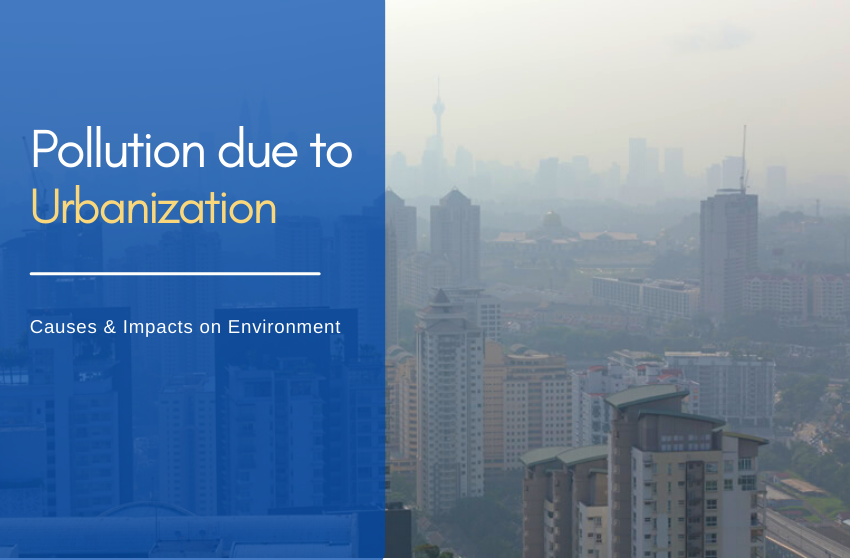Pollution Due To Urbanization – Causes & Impacts on Environment

A region that is converted from a rural or inhabited area into an urban area is known as Urbanization. It signifies the movement of people from rural to urban areas. With the introduction of urbanization, there can be an increase in the number of cities, population, and industrialization which directly or indirectly affects our ecosystems. Due to the uncontrolled urbanization only, environmental degradation has been arising very rapidly and is caused by many problems such as land insecurity, worsening of water quality, excessive air pollution, noise pollution, and the problems of waste disposal. According to a study, effective and preventive measures should be taken on the existing cause of damage to the environment due to urbanization. As it is impossible to restrict urbanization so it should be ensured that urbanization should proceed on the right path.
Table of Contents
Causes of Urban Pollution
- Air Pollution: With the increase in population and industries the air in urban areas is always polluted with toxic substances. Which is becoming dangerous day by day to breathe as the air present inside cities is suffocating. The different cause of air pollution in the cities is smoke from automobiles, factories, and power generators which makes the air unhealthy. The other factors that contaminate the air are chemical spills and other toxic gases.
- Water Pollution: Water, one of the most important natural resources of our environment, is being polluted day by day. There can be a different source of water pollution from industries to households to individuals. As the waste is disposed of directly to water from various sources that have arisen many water diseases.
- Soil Pollution: The other cause of urban pollution is soil pollution. It occurs due to the mixing of toxins in the soil by industries or other sources. Which affects agricultural products.
- Noise Pollution: One of the noisiest regions in the world is urban areas. With the population, it gives rise to various sources of noise pollution like traffic noises, loudspeakers, and other unwanted noises. It may cause many health issues like depression, mild deafness, etc.
- Radioactive Pollution: It is caused due to the fortuitous leakage by nuclear power plants which poses a threat to our environment.
- Visual Pollution: One of the most common pollution in urban areas is visual pollution. Signs, Billboards, Screens, high-intensity lights, etc are pretty disturbing and distracting due to the overexposure of visuals in cities.
- Other than these there is also ‘Thermal Pollution’ which is caused by an extreme amount of heat trapped in the earth’s atmosphere.
Most Polluted Cities in the World
Here are given the top 20 most polluted cities according to the 2020 mid-year report:
|
Rank |
Name of Cities |
Pollution Index |
|
1 |
Tetovo, North Macedonia |
97.44 |
|
2 |
Kabul, Afghanistan |
96.53 |
|
3 |
Kathmandu, Nepal |
95.88 |
|
4 |
Faridabad, India |
95.19 |
|
5 |
Ghaziabad, India |
93.77 |
|
6 |
Ulaanbaatar, Mongolia |
93.76 |
|
7 |
Dhaka, Bangladesh |
93.37 |
|
8 |
Beirut, Lebanon |
93.32 |
|
9 |
Accra, Ghana |
93.19 |
|
10 |
Noida, India |
92.85 |
|
11 |
Ho Chi Minh City, Vietnam |
92.34 |
|
12 |
Cairo, Egypt |
91.92 |
|
13 |
Gurgaon, India |
91.63 |
|
14 |
Yangon, Myanmar |
91.30 |
|
15 |
Delhi, India |
91.00 |
|
16 |
Allahabad, India |
90.83 |
|
17 |
Hanoi, Vietnam |
90.61 |
|
18 |
Kanpur, India |
90.46 |
|
19 |
Manila, Philippines |
90.04 |
|
20 |
Patna, India |
89.92 |
Impacts of Urbanization on Different Components of Environment
Most of the important environmental problems will emerge in the future if the existing problems do not receive enough political attention. As the problems are not significantly noticed in many countries or the situation is being detected but nothing has been done for it. The most emerging issues that we are facing today are climate changes, freshwater scarcity, deforestation, and freshwater pollution, and population growth. These problems are very intricate and hard to define. It is very essential to examine problems through the social-economic-cultural system. Different impacts of pollution on our environment are as follows:
Impacts on Atmosphere and Climate
1. Change in Temperature
Cities remain warm at night when the countryside has already been cooled. It is due to the making of heat-absorbing materials like concrete, asphalt, bricks, etc which are used in building, household, industries, etc. The reflection of heat works differently than that of vegetation and soil.
2. Changes in Air Quality
A wide range of harmful gases is discharged due to human activities. Various gases that are released in the environment are carbon dioxide, carbon monoxide, sulfur oxides, nitrogen oxides, lead, and many other pollutants. This gives rise to respiratory diseases like Asthma, Tuberculosis, acute respiratory infections, etc are most affected by the people living in urban areas.
3. Changes in Patterns of Precipitation
As cities are warmer than the surrounding countryside, it often receives more rainfall. Since dust can stimulate the precipitation of water vapour into rain droplets.
Impacts on Lithosphere and Land Resources
1. Erosion and other changes in the quality of land
High levels of erosion and sedimentation in river channels are the result of rapid developments. The construction of buildings, roads, etc gives rise to deforestation which results in erosion and changes in the quality of the land.
2. Pollution
Burying a huge amount of waste in the ground results in land pollution. Pollutants are usually scattered over cities or concentrated in industrial areas or waste sites. Lead-based paint that is used on roads, highways, and buildings is one such example of a widely dispersed pollutant that found its way into the soil.
Impacts on Hydrosphere and Water Resources
1. Flow of Water into Streams
Unlike rural areas, urban areas are not surrounded by natural vegetation and undisturbed soil which are substituted with concrete, asphalt, brick, and other water-resistant surfaces. It means that when it rains in cities water is less likely to be absorbed into the ground. Which results in the direct flow of rainwater into river channels or streams.
2. Degraded Water Quality
With time the water quality has degraded due to urbanization. As all the city’s waste is deposited in rivers. That eventually leads to increased sedimentation thereupon increasing the pollutant in the run-off.
Impacts on Biosphere
1. Alteration of Habitats
The fertilizers that are spread across yards to promote the growth of plants find its way into water channels at the expense of fishes. The waste which is dumped into streams lowers the level of oxygen during its decay and results in the perishing of plants and animals.
2. Disruption of Habitats
As an outcome of urbanization complete eradication of habitats can be seen in cities. As a result, native species of the particular place are driven out of cities.
Other Impacts of Urbanization on the Environment
The other important effect of urbanization on the environment is a major increase in greenhouse gasses which creates an excessive risk to the environment. These are those gaseous components of the atmosphere that absorb and release radiation at a specific wavelength. The absorption of greenhouse gasses (GHG’s) in the atmosphere has rapidly increased due to the man-made activities connected to the urbanization growth which results in an irrelevant increase in the temperature of the earth. These gases absorb the energy radiated from the sun making the lower part of the atmosphere warmer. This foremost aspect is known as a natural greenhouse gas effect. These effects expanded with the emission of gasses from various man-made activities ensuing to industrialization and urbanization.
1. Industrial Sector
A major source of greenhouse gas emissions is industries. One-third of global carbon dioxide emission is due to the industrial sector only. In India, and other countries as well industries are the main source of emission of harmful gases. Industries like the steel industry, thermal power, cement plants, chemical production, and other industries mostly emit carbon dioxide and other harmful gases.
2. Waste Generation
The waste sector mainly contributes to the emission of carbon dioxide due to the waste burning of the inorganic matter when there is no energy renewal. Annual anthropogenic methane is produced approximately 10-23 percent and is discharged into the atmosphere. Both domestic and industrial water source wastewater treatment may be responsible for ten percent of anthropogenic methane emissions.
3. GHGs emissions due to the transportation sector
Most of the greenhouse gas emissions are due to the transport sector in urban areas. Due to an increase in the number of vehicles on the roads, there is an increase in the emission of harmful gases into the atmosphere. The traffic structure of the megacities of India (Delhi, Mumbai, Kolkata, Chennai, Bangalore, and Hyderabad) represents that there is a tangible shift from the share of slow-moving vehicles to fast-moving vehicles and public transport to private transport. For example, Delhi’s transport sector generates six times as much greenhouse gas discharges (GHG) as that of Kolkata’s, five times as much as Ahmedabad’s and three times as much as Greater Mumbai and Chennai Followed by Banglore and Hyderabad, Delhi’s transport sector emits 12.39 million ton of carbon dioxide. As compared to other Indian cities Hyderabad emits the greatest portion of GreenHouse gases according to 2015 reports.
Impact of Urbanization in Indian Cities
The main impact of urbanization on the environmental quality in Indian cities are:
- The total slum population according to size or class of towns in India during 1991 shows that 41% of the total slum population was living in million-plus cities, where 27% of the total population of India lives.
- According to the status of Municipal solid waste generation and collection in Metropolitan Cities of India Maharashtra generates the largest amount of municipal solid waste which is 11,000 tonnes/day followed by Delhi (8700 tonnes/day) in 2019 which are most likely to be increasing in near future.
- Growth in motor vehicles in India and other Metropolitan Cities.
- There has been an increase in the number of vehicles used in India and other metropolitan cities. An average of 10% or more increase has been found in the use of vehicles which is a major concern for air pollution.
- Due to the increase in population, wasteful consumption, and negligence of conservation, water resources are diminishing day by day. With an increase in urbanization and industrialization, huge quantities of wastewater enter rivers which affect the river streams that are used for drinking and purposes.
Conclusion
Urbanization lies in the enactment and the regulating agencies of the country. Due to some bad decisions of governance, today’s cities resulted in the growth of informal settlements and slums that constitute unhealthy living and working environments. Serious attention should be given to the need for improving urban strategies, which promote productivity in resource use. In metropolitan cities, top priority should be given to the control of Vehicular pollution. Primary attention should be addressed to reduce the generation of solid waste. In case adequate steps are not taken to prevent pollution and to improve the quality of life by providing more social amenities, the life of the urban inhabitants of metropolitan cities may become more discontented this may be the cause of health hazards and worst devastation. We can follow these major steps also:
- By promoting economic development and creating jobs we can combat poverty which is also an important aspect of urbanization.
- We can involve local communities who are working for the environment.
- By upgrading energy use and alternative transport systems we can reduce air pollution.
- Waste disposal and housing facilities can be provided through a private-public partnership.
- A key element in urban planning is to plant trees and incorporate the care of city green spaces.





